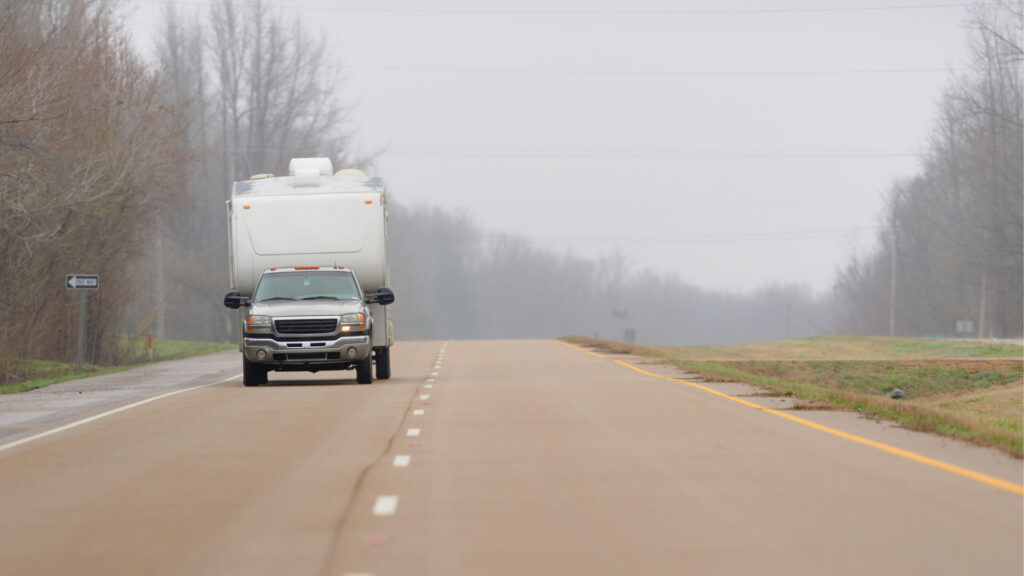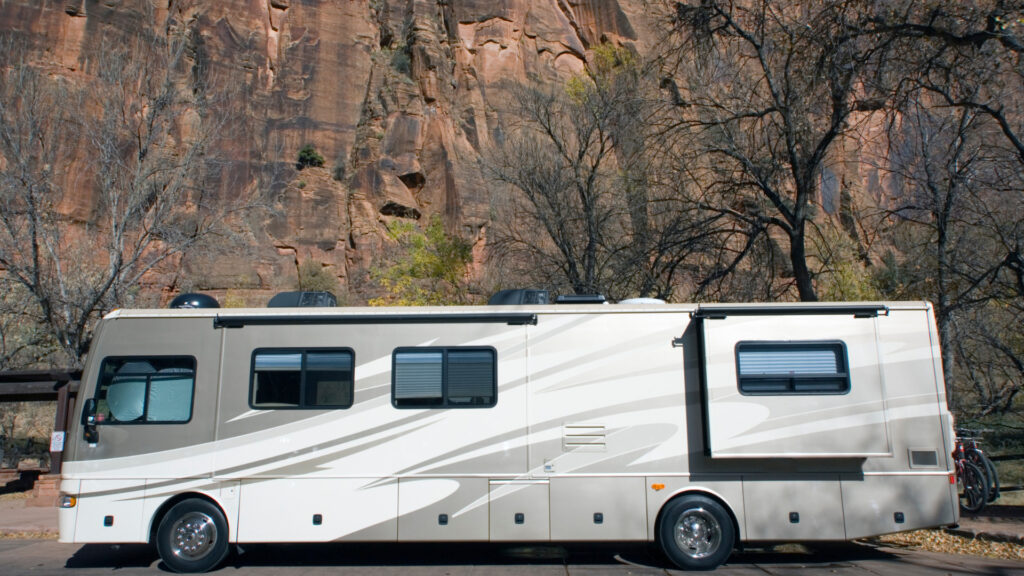Table of Contents Show
Although we all hope for beautiful sunshine and pleasant weather when we plan a camping trip, that isn’t always what we get. Bad weather, including rain, thunderstorms, and extreme temperatures, can dampen the experience. You may also encounter driving your RV in high winds.
These gusts can make you feel as though your RV will tip over. Although we don’t recommend driving in high winds, if you must, we have a few tips to keep you safe. Let’s dive in!
What Is the Definition of High Winds?
The National Weather Service defines “high winds” as winds with sustained speeds of 40 to 57 miles per hour.
It goes on to explain that in these winds, small branches break off trees, loose objects are blown about, and porches, carports, and awnings sustain damage. Frequently, power outages occur.
The National Weather Service may warn high-profile vehicles that driving may be unsafe under these conditions.
When Is It Too Windy to Drive an RV?
Avoid driving an RV in winds of 45 to 50 miles per hour or more if possible.
Once you get into high winds, a gust can topple high-profile vehicles like RVs because they have a large surface area. Even if winds don’t tip over the RV, they’ll certainly thrash you about, potentially causing you to lose control.
It’s important to note that even if you’re driving in winds of only 30 to 35 miles per hour, you should still pull over if you don’t feel safe.
Don’t wait for the National Weather Service to issue a warning. Recognize your limitations. Drive in what feels safe to you and your passengers. White-knuckle driving and anxiety don’t lead to an enjoyable travel day.

What Are the Dangers of Driving in High Winds?
The worst possible outcome of driving in high winds is getting in an accident. A 60-mile-an-hour gust can send your RV reeling. Not only does it endanger your life and the lives of your passengers, but an out-of-control RV also risks swerving into another lane and colliding with other vehicles.
Another danger of driving in high winds is the increased stress level for the driver and everyone in the RV or tow vehicle. Anxiety leads to poor decision-making, curt responses to loved ones, and exhaustion. You don’t want to experience this kind of travel day.
The constant tug-of-war with the wind can lead to swerving in and out of your lane and going off the shoulder. Even the most capable heavy-duty trucks won’t be able to control a travel trailer or fifth wheel in high winds.
7 Safety Tips for Driving in High Winds With an RV
If you have to drive in high winds, there are a few things you can do to stay safe. But you may find yourself eventually pulling over for a bit. Driving in high winds is no joke.
1. Always Check the Weather
As an RVer, you should be on top of the weather. RVs aren’t built like houses. Dangerous weather exists nationwide, from tornadoes to hurricanes to extreme temperatures to high winds. Therefore, stay alert.
Instead of checking an app the morning of a drive day, start following the weather several days before leaving. That way, if you see dangerous weather conditions coming, you can leave early or plan to stay later until it’s safe to hit the road.

2. Shift Weight in RV to Over Wheelbase
To prevent sway, load up your cargo over the wheelbase in the rear of the RV. This will make your rig seem heavier even though you haven’t added any weight.
By shifting the weight, you can ease the bouncing and swaying that high winds cause.
3. Drive Slower
This shouldn’t need to be said, but in any severe weather, slow down. Instead of asking how fast you should go, drive what feels comfortable and safe.
Remember, the faster you go, the less control you have over the RV and the less time you have to slow down if something wrong occurs.
4. Don’t Overcorrect
If you feel the wind pushing your RV around, don’t overcorrect. Any jerky movements could end in disaster.
Smooth and steady wins the race when it comes to driving in high winds. Remain calm as best you can, and gently steer the vehicle back to where it should be.
Keep in Mind: We don’t recommend driving in fog either, but if you have to, you should always do this!
5. Be Prepared for Gusts
You can’t predict the weather but be prepared for larger gusts. These typically happen when big trucks pass, or you drive under a bridge.
As you watch your rearview mirror, hold the wheel steady with both hands and get ready to feel a wind spike that may push or pull you around.
6. Drive Into the Wind If Possible
Another part of checking the weather several days before leaving is choosing a safe route. If you can drive a bit farther north to avoid the high winds warning area, then adjust your route. It’s also better and safer to drive a longer distance into the wind rather than getting side-swiped.
7. Stop If You Feel Unsafe
No matter what, stop if you feel unsafe. This goes for nighttime driving, driving in heavy rains, driving in high winds, or any other time you’re over-anxious. It’s not worth continuing on.
Find a rest area or truck stop and wait it out. You may even have to find a place to stop for the night and start your drive again the following day. It’s better to arrive a day or two late than not at all.

Can High Winds Blow Over a Stationary RV?
If you don’t plan on driving in high winds but are camping during high winds, you’re not completely safe from potential problems. Although stationary RVs can withstand pretty high gusts, the direction the wind blows can also impact your safety.
But just like you may need to pull over when driving in high winds, you may need to leave your RV and head to a hotel, clubhouse, or other building to stay safe.
When you discover that a windy day is forecasted, you can do some things to prepare.
Consider filling up your tanks to weigh down your RV, like shifting the weight over the wheelbase to get a lower center of gravity. If you have a towable trailer, you might connect to the tow vehicle if you’re on level ground. This will provide more stability.
Always pull your awning in. Pick up and put away loose toys, camping chairs, and other outdoor gear. Stake down an outdoor patio mat. When there are very strong winds, pulling in your slides will reduce the surface area of your RV.
Sometimes, if you know the direction of the wind, you can turn your RV to face it so that the winds hit the front of your rig instead of the sides.
Although RVs can flip over in windy conditions, it’s not likely. Most can withstand up to 75-mile-per-hour winds.
It will feel much worse inside the RV than it probably really is. But by taking precautions, you can reduce the sway and help alleviate your fears.
Keep in Mind: Are you prepared for winter camping? Stay warm this winter with the right camping gear for cold weather!
Stay Safe When Driving in High Winds This Camping Season
If you can avoid driving in high winds, please do. These conditions aren’t safe for high-profile vehicles like RVs. But if you must, follow these tips so you arrive at your next destination safe and sound.
Have you ever been worried for your safety in an RV because of high winds?






